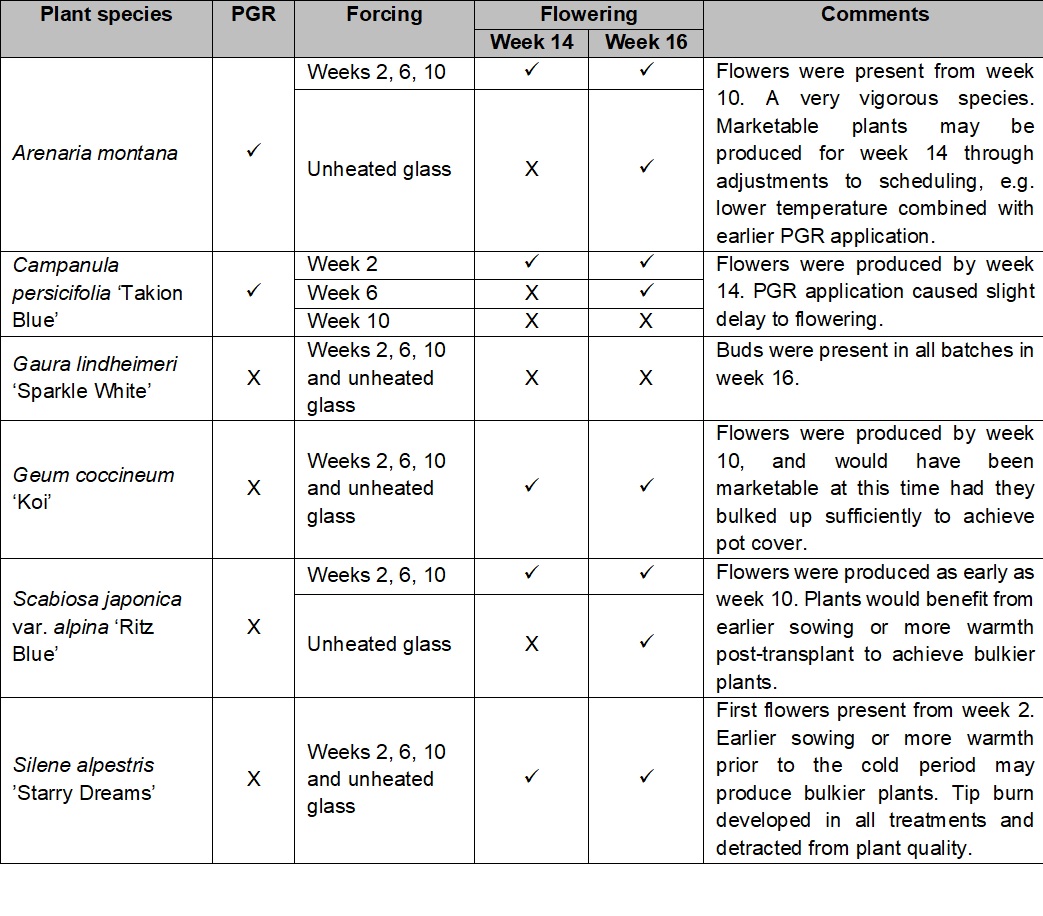Please click here to access the main AHDB website and other sectors.
- Home
- Knowledge library
- Forcing herbaceous perennials for early spring sales
Forcing herbaceous perennials for early spring sales
A range of herbaceous perennial species can be programmed to produce a marketable impulse product in late winter, however such programmes generally require the use of a cold store for ‘out-of-season’ vernalisation of the plant material, supplementary lighting and an input of heat to attain such an early marketing date. Clearly, such product would therefore need to be sold at a premium price. However, research has shown some species can be forced into flower during late March/early April with the addition of heat alone, using plant growth regulators to produce a high quality, uniform crop.
Bedding and Pot Plant Centre research
Research was carried out within the Bedding and Pot Plant Centre work programme to force perennial species into flower by late March/early April under a minimal energy input regime. Four seed-raised perennial species: Arenaria montana, Geum coccineum ‘Koi’, Scabiosa japonica var. alpina ‘Ritz Blue’ and Silene alpestris ’Starry Dreams’ were forced into flower by weeks 14-16 through application of heat alone from as late as mid-March. Campanula persicifolia ‘Takion Blue’ flowered by week 14, but required heat from mid-January or mid-February. While Gaura lindheimeri ‘Sparkle White’ did not produce open flowers by early April. Silene alpestris ‘Starry Dreams’ and Geum coccineum ‘Koi’ were capable of producing fully open flowers by week 14 under glass with frost protection only.
Considerations for early spring production
Inputs: Consider if existing production facilities are suitable or available at low cost, as ‘built-for-purpose’ facilities will not be cost effective. Early spring production is likely to be more cost effective where biomass heating systems are already installed. Facilities need to be equipped to provide frost protection as a minimum in the UK.
Plant species selection: Careful species selection is necessary, focusing on those that provide sufficient impact for early spring production and are naturally compact. Investigate new breeding in potential suitable crop species with suppliers. Use of seed-raised varieties will be more cost effective. Determine the day-length requirement of each species and focus on short-day or day-neutral plant species, and be aware of any vernalisation or cool period needed to induce flowering.
Production system: Match the species to pot or pack size. Not all species will be sufficiently vigorous to cover a 13cm pot by early spring, although this may be achieved through adjustments to scheduling. Larger plug plants usually produce final plants with better habit and more flowers at marketing, depending on species.
On site trials: Carry out nursery based trials to determine suitable scheduling requirements prior to large scale production.
Scheduling processes to advance flowering
Forcing perennial species into flower early requires plants to pass through specific processes to ensure they are mature enough, and have received sufficient vernalisation to flower. They also need to be large enough to achieve pot or pack cover at marketing. Plant growth regulator applications may be necessary to control plant height and habit for some species, and to prevent soft growth.
Example schedule for late March/early April sales period
Sowing - sow seed between weeks 27-33, depending on plant species.
Transplanting - earlier transplant dates can improve final plant quality, particularly for less vigorous species. Transplant from week 40 onwards.
Growing on - establish plants for around two weeks at 14˚C to promote rooting and allow plants to bulk up prior to any cool treatment.
Cool period - provide a cool treatment from week 42. Minimal frost protection is required during the cool treatment either under polythene tunnels or glass. For example heat: 2-4°C/vent: 4-6°C, depending on plant species.
Forcing - this entails provision of heat to bring plants into growth following the cool period, and is usually undertaken under glass. For marketing in weeks 14-16 provide heat from week 2 onwards (heat 12°C/vent 15°C).

Cool treatment: frost protected polythene tunnel, heat 2°C/vent 4°C followed by unheated glass with frost protection from week 50. Forcing: heated glass, heat 12°C/vent 15°C.
Other notes in this series:
Management of bought-in cutting material to retain quality
New plant growth regulators for use on pot- and pack-grown bedding plants
New plant growth regulators for use on poinsettia
The use of spectral filter polythene in bedding plant production
The use of spectral filter glass coatings in the production of protected ornamentals
Have a question?
 web.jpg)

